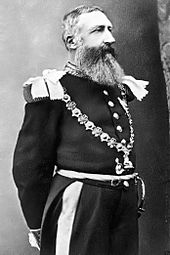The Congo Free State. Sounds like a wonderful place, right?
Oh, it wasn’t.
I mean, I’m sure it was at some point in history, but then my next pick came into the picture…
King Leopold II of Belgium
If you’ve read Heart of Darkness, you’ll have a good idea of how this story goes.
We begin with the Berlin Conference of 1885, a meeting of Europe’s leaders to discuss New Imperialism – African colonialism and how it should be regulated among the colonizers. (As an aside, it’s incomprehensible to me that the leaders of an entire continent met to decide how they would divvy up another entire continent – with millions of people and everything! Colonialism is disgusting.)
Leopold attended this conference, having been interested in owning part of Africa for some time. He originally wanted Belgium to get into the colonial game, but there was no public support for it at home. So he persuaded all these leaders to let him personally have some land in central Africa, under the guise of humanitarian aid, local development and civilizing the natives. (It always comes back to racism, doesn’t it?) He got Henry Morton Stanley (“Dr. Livingstone, I presume?”) to survey the area and arrange “treaties” with tribal leaders:
“The treaties with these little African tyrants, which generally consist of four long pages of which they do not understand a word, and to which they sign a cross in order to have peace and to receive gifts, are really only serious matters for the European powers, in the event of disputes over the territories. They do not concern the black sovereign who signs them for a moment.”
Lovely. And that’s how an entire country came into the possession of a single man who never even set foot in the place. That’s not even remotely the end, though.
The Congo Free State was intended to be run as a profitable business, similar to, say, the Dutch East India Company. But, despite some ivory farming and mining, finances were constantly poor for the first few years. However, the invention and popularization of the bicycle around 1890 caused a big boom in natural rubber. And that’s where the story turns, because rubber just happened to be in huge supply in the Congo Free State — if you could get people to produce it. And Leopold and the companies contracted to him wanted to produce it very badly.
How badly? Badly enough that they essentially forced the entire Congolese population into quasi-slavery to meet production quotas. Leopold commissioned a private army, the Force Publique, to maintain order and ensure that the increasingly impossibly rubber quotas were met. The Force used inhuman methods — if you refused to participate or weren’t meeting standards, you could be bullwhipped, your family could be kidnapped and taken hostage. Or you could just be shot. As an added sadistic touch, the Force cut off the hand of anyone they shot to prove how they had used the bullet (WTF???). This led to some truly horrific scenes:
As a consequence, the rubber quotas were in part paid off in chopped-off hands. Sometimes the hands were collected by the soldiers of the Force Publique, sometimes by the villages themselves. There were even small wars where villages attacked neighbouring villages to gather hands, since their rubber quotas were too unrealistic to fill.
The baskets of severed hands, set down at the feet of the European post commanders, became the symbol of the Congo Free State. … The collection of hands became an end in itself. Force Publique soldiers brought them to the stations in place of rubber; they even went out to harvest them instead of rubber … They became a sort of currency. They came to be used to make up for shortfalls in rubber quotas, to replace … the people who were demanded for the forced labour gangs; and the Force Publique soldiers were paid their bonuses on the basis of how many hands they collected.
One junior officer described a raid to punish a village that had protested. The officer in command “ordered us to cut off the heads of the men and hang them on the village palisades … and to hang the women and the children on the palisade in the form of a cross”.
All of this in addition to the usual results of colonization — famine, new diseases, wars. All in all, as many as 15 million Congolese died at the hands of Leopold.
But the severed hand stories are going to stick with me for a while.
@Riverman is up.
